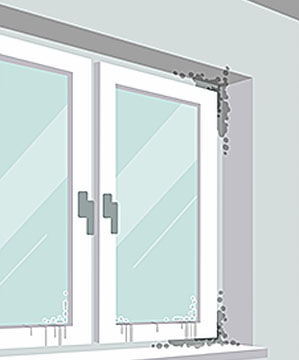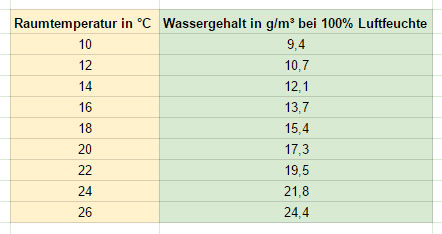BachNagel » Gesundheit » Mould formation

Humidity & mould growth
A pleasant room climate is an essential prerequisite for feeling at home. The quality of the room climate is influenced not only by temperature but also by humidity.
In general, a relative humidity of 45% to 70% is considered a comfortable and healthy indoor climate.
Humidity - Blessing or Danger?

Temperature factor
The air has the property of absorbing moisture in the form of water vapour. This property depends above all on the temperature. The warmer the air, the more water vapour it can absorb and the saturation concentration increases. For example, at atmospheric normal pressure of 1013.25 hPa, 1m³ air at 0°C can absorb a maximum of 4.8g of water. The same amount of air absorbs 9.41 g of water at 10°C. At 20°C the maximum humidity is 17.3 g per water per m³.

Factor Ambient humidity
An average household releases about 10 litres of water per day through the natural release of moisture from people, animals, plants and everyday activities.
| Sleeping Human | 30-50g Water per hour |
| People doing housework | 90g Water per hour |
| People at hard work | 175g Water per hour |
| Medium potted plant | 7-15g Water per hour |
| Cooking processes | 600-1500g Water per hour |
| Use of shower and bathtub | 2600g Water per hour |
The number of water molecules in the air depends on how many water molecules evaporate in the environment (evaporation rate) and how many recondensate (condensation rate). The air does not always contain the maximum amount of water vapour that could be contained at the corresponding temperature.
The ratio, expressed as a percentage, of the actual mass of water vapour to the maximum possible mass of water vapour in the air is the relative humidity.
The relative humidity indicates the degree to which the air is saturated with water vapour:
At a relative humidity of 50%, the air contains only half the maximum amount of water vapour that could be contained at the corresponding temperature. At 100% relative humidity, the air is completely saturated with water vapour.
Since the relative humidity depends on the air temperature, the storage capacity of the air varies. The air temperature at which the relative humidity is 100 percent is the dew point temperature. If this is not reached, the air separates water vapour as dew.

Modern windows must be absolutely windproof due to the regulations of the window energy saving regulation, in contrast to older windows they do not allow air circulation. The humidity in the room increases. This causes the dew point to shift upwards.
This dew point table indicates at which interior surface temperatures condensate occurs as a function of the room air temperature and relative humidity.
Example: At 20°C room air temperature and 70% relative humidity, the dew point temperature is 14.4°C.

If the moist air cools down below 14.4 °C on cold components such as windows, its water storage capacity is reduced. The air releases the excess humidity in the form of condensation that settles on these cold components.
This phenomenon is particularly noticeable when the heat is prevented from reaching the window by a curtain or pleated blinds, etc. The window cools down and condensation occurs.
Mould quickly develops on the panes, in the window soffit and on the seals due to condensation. If mould has developed, the harmful spores must be removed as quickly as possible.
These renovations are usually time-consuming and costly.
Affected silicone sealing material must be removed and re-sealed by a specialist to prevent leakage and energy loss. Affected surfaces must be treated with mould remover, chemical bleaching agents, special cleaners or high-proof alcohol.
If wood is infected, simple cleaning is usually not sufficient, as the mould can easily penetrate into the natural product.
In this case, window reveals usually have to be re-wrapped and, if necessary, replastered.
Persistent mould and moisture due to the dew point at the windows is annoying for owners and residents.
To prevent internal condensation we recommend
More to heat, because if there is not enough warm air, the window cools down, despite a good heat value.
However, heating is known to have a negative impact on the environment and the bank account
Alternative: to ventilate more (so that moisture goes out of the room).
But especially in winter, care must be taken not to dry the air too much, because if the cold outside air, which has only a low absolute humidity, is heated to room temperature, its relative humidity drops sharply. This often results in air humidity values that are significantly below the medically recommended values.
A too low humidity damages the skin, which needs a high humidity in order not to dry out. Skin redness or even skin inflammation can occur. Mucous membranes are particularly at risk because they depend on high humidity to maintain their functions. Nosebleeds are more frequent and the risk of catching a cold increases.
Ventilation, as recommended, is neither ecological nor economical and can even be harmful to health.
A rule of thumb is to ventilate every full hour for at least five minutes with the window sashes fully open.
Calculations show that this hourly ventilation requires approximately 6 litres of heating oil per m² per year. That means for a single-family house with 140 m² usable area one needs 840 litres of oil per year, which increase the carbon dioxide emissions and with the today’s oil prices calculated on 555€ per year come.
More heating, ventilation and wiping every hour is not a practical solution in the long run.
Studies commissioned by the Fraunhofer Institute show that a roller shutter reduces the U-value of the glazing (Ug) from about 1.1 W/m²K (without roller shutter) to 0.80 W/m²K (glazing and roller shutter).
Therefore, the best and cheapest remedy against condensation near the window is to prevent it from cooling down and to attach a roller shutter to the window.
Condensation from outside
The better the thermal insulation of the insulating glass, the more likely is the formation of external condensate in certain weather conditions or, if there is frost, from a layer of ice on the outer surfaces of the panes.
Even at low temperatures, the glass pane radiates heat in the form of infrared radiation. If the sky is cloudless, this radiation goes into space, which in turn radiates cold to the earth. A window is a solid body and emits more heat than the air, which is gaseous. The disc becomes colder than the surrounding air, whose moisture is deposited as condensate on the disc.
Again, the best and cheapest solution to avoid external condensation on the outside surface of the window is to prevent the window from cooling down by installing a roller shutter.
The best and cheapest remedy against internal or external condensation on the window is to prevent the window from cooling down by installing a roller shutter.
